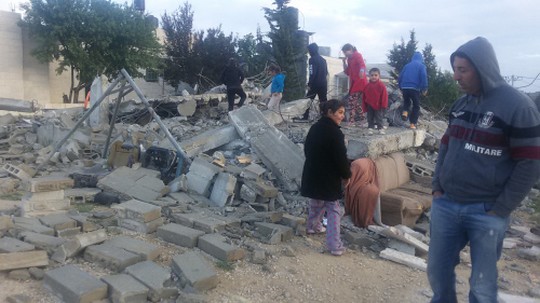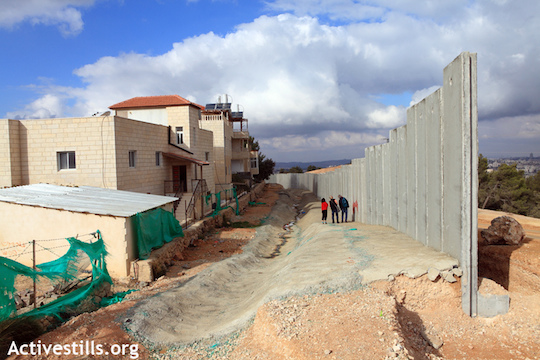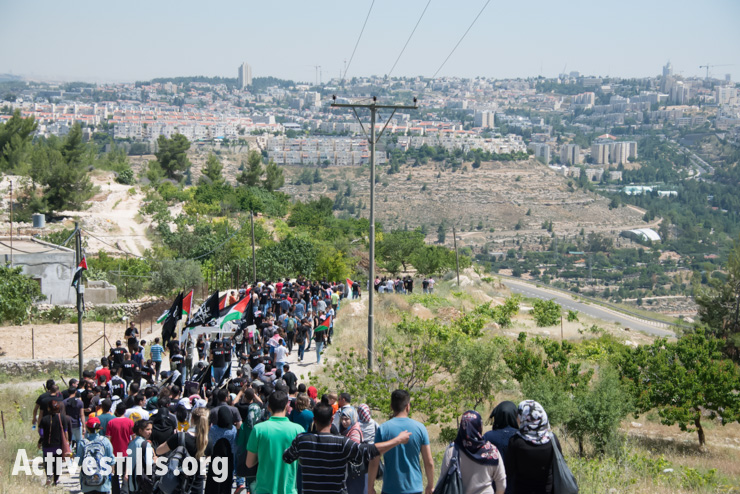Israeli authorities destroy three homes in al-Walaje, a village that was partially annexed to Jerusalem, yet has been totally neglected by the municipality.
By Aviv Tatarsky

Israeli authorities demolished three homes in the Palestinian village of al-Walaja on Tuesday. Bulldozers accompanied by Israeli soldiers raided the village at approximately 4 a.m. and began demolishing a home with two units that have yet to be occupied, a family home of five, and a home of Mahmoud, a young man who just got engaged.
The demolitions in the village are part of a larger wave of home demolitions across the West Bank over the last months, including in Khirbet Tana, Umm al-Khir, the Bedouin communities between Jerusalem and the settlement of Ma’ale Adumim, and more.
Hundreds of people have lost their homes and entire communities are in danger of expulsion. Settler groups such as Regavim, along with people such as MK Moti Yogev (Jewish Home) have been putting pressure on the authorities to carry out the demolitions, whose entire purpose is to expel Palestinians from Area C of the West Bank, under full Israeli civil and military control. The Jewish Home party’s formal plan is to annex Area C to Israel, leaving the rest of the Palestinians imprisoned in Areas A and B.
From the first day we came to stand alongside al-Walaja, the residents of the village have told us: “Israel doesn’t want us here, the state is trying to remove us.”
The demolitions in al-Walaja may have far-reaching consequences, beyond the three the homes that were destroyed. Ever since the beginning of the construction of the separation wall, which has disconnected the village from Jerusalem — and despite the fact that nearly a third of the village was annexed to and is considered part of Jerusalem’s municipal jurisdiction — Israel refrained from demolition homes there. In North Jerusalem, too, there are eight Palestinian villages — where over 100,000 East Jerusalemites live — that were disconnected from the city by the separation wall. The municipality stopped demolishing houses in every single village left behind the wall — a cold comfort when considering the total neglect of these neighborhoods.
The sight of a demolished home is a horrible thing. It is difficult to see a family that, just moments ago, lost their house. I visited Mahmoud’s family a day after the demolition. His father, Maher, spoke with a measured, soft voice, showing us the couches crushed under the rubble of the destruction, as he calmly explained what happened. The young men, Mahmoud’s friends, spoke briefly and were even friendly to the Israelis whose army destroyed their friends’ home that very morning. Mahmoud himself was broken. He sat inside and barely uttered a word.

Mahmoud, who is in his early 20s, is an energetic and optimistic person. He has initiative and is happy with his job as a chef in Bethlehem, and is planning on opening his own restaurant. When considering how futile life feels in Walaje, and the number of restrictions his family members have faced, Mahmoud’s spirit is not to be taken for granted. So here, Israel showed him just how futile it is for a Palestinian to imagine a life of normalcy.
There are those who will say that the demolitions happened in accordance with the law, and that the criminals have no right to complain. But the fact is that Israel created a reality in which the people of al-Walaja have no way of building legally. Despite the annexation to Jerusalem, the municipality has never once produced a master plan for the village, which prevents its residents from obtaining building permits.
The municipality rejected a master plan presented by the residents, along with Israeli NGO Bimkom and architect Claude Rosenkowitz. On the other hand, the state approved building in the adjacent Israeli settlement, Har Gilo, as well as the Jerusalem neighborhood of Gilo. Parts of both Har Gilo and Gilo are built on al-Walaja’s land. In the village, however, building is not allowed. Neither Jerusalem municipality nor the state itself has ever provided services or invested a single shekel in the annexed village, whether on paving roads, schools, family health centers, or trash clean-up.

Moreover, it turns out that the demolition of Mahmoud’s home was done illegally (we do not know if the same goes for the other two homes that were demolished): building inspectors submitted a demolition order before midnight of last Sunday. The following morning the family spoke to a lawyer who rushed to the court and successfully obtained a court-ordered delay until the end of proceedings. Regardless, 30 hours after the inspectors gave the warning, bulldozers demolished the family home while flagrantly ignoring the court.
It is difficult to stand before the destructive force of the state. Despair is a privilege that we must not allow ourselves. There is always something we can do: work together with village residents, re-build what has been destroyed, create and sustain human ties. Those who cannot make it to the village can tell friends, organize events, donate to human rights organizations, or any small gesture to bring about a political change that is so necessary.
Aviv Tatarsky is a researcher with Ir Amim. A version of this article was first published in Hebrew on Local Call. Read it here.

